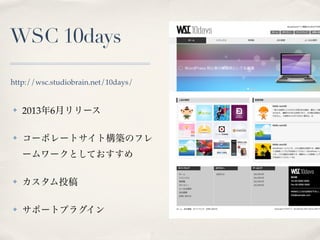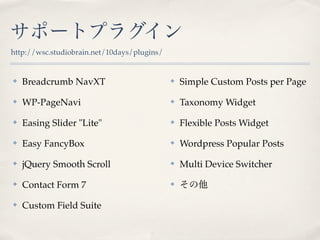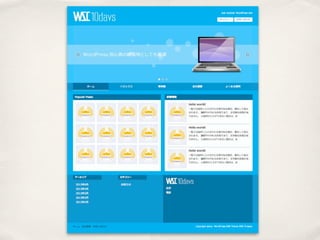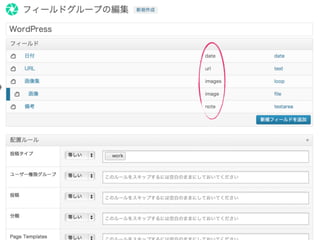1 of 11
Download to read offline











Ad
Recommended
SaCSS vol.79ĄžCMS€«?€é€ß€Î„”„€„È€ÎÊÜ°kŚą€Æ?Ž_ŐJ€č€Ű?€€ł€ÈĄč
SaCSS vol.79ĄžCMS€«?€é€ß€Î„”„€„È€ÎÊÜ°kŚą€Æ?Ž_ŐJ€č€Ű?€€ł€ÈĄčSeiko Kuchida
?
SaCSSŁšÔę»Ï„ł©`„Ç„Ł„ó„°Ăă»áŁ© vol.79€ÎÙYÁÏ€ËŃaŚă€òŒÓ€š€ż€â€Î€Ç€čĄŁCMS€òÀûÓĂ€·€ż„”„€„È€òÖÆŚś€č€ëÇ°Ąą„Ç„¶„€„Ê©`?„ł©`„À©`€Ű€Î°kŚą?ŚĆÊÖÇ°€Ë„Ç„Ł„ì„Ż„·„ç„óévßB€ÇŽ_ŐJ€č€Ù€€ł€È€òœBœé€·€Æ€€€Ț€čĄŁ20191204łć°ÂŽÇ°ù»ć±Ê°ù±đČőČő€ÎœÌżÆÊéłö°æŒÇÄî„€„Ù„ó„Èłć„Ï?„Ő„©©`„Ț„ó„č„Á„ć©`„Ë„ó„Ż?€È„»„„ć„ê„Æ„ŁłćĐĄŽš
20191204łć°ÂŽÇ°ù»ć±Ê°ù±đČőČő€ÎœÌżÆÊéłö°æŒÇÄî„€„Ù„ó„Èłć„Ï?„Ő„©©`„Ț„ó„č„Á„ć©`„Ë„ó„Ż?€È„»„„ć„ê„Æ„ŁłćĐĄŽšTomoya Hokari
?
2019Äê12ÔÂ04ÈŐ€Ëé_Žß€·€żWordPress€ÎœÌżÆűłö°æÓÄî„€„Ű?„ó„È€ÎĐĄŽš€ÎÙYÁÏ€Ç€čĄŁWordPress€Ë€Ș€±€ë„Ï?„Ő„©©`„Ț„ó„č„Á„ć©`„Ë„ó„Ż?€È„»„„ć„ê„Æ„Ł€òœBœé€·€Æ€€€Ț€čĄŁ
Ąș„Ó„ž„Í„č„”„€„È€òŚś€Ă€Æѧ€Ö WordPress€ÎœÌżÆű Ver.5.xê°æĄ»
https://amzn.to/2qcjkRO
„”„ó„Ś„ë„”„€„È
?https://wpbook-pacificmall.work/čĆ€ÁŒ€Rails„Ś„í„ž„§„Ż„È€Ë wepback€Èvue.js€ò§È뀷€żÔ
čĆ€ÁŒ€Rails„Ś„í„ž„§„Ż„È€Ë wepback€Èvue.js€ò§È뀷€żÔYuya Taki
?
žéČčŸ±±ôČő€ËŽÚ°ùŽÇČÔłÙ±đČÔ»ć„Ç„Ł„ì„Ż„È„ê€ò”ŒÈ뀷·É±đČú±èČ賊°ì€ÈłŐłÜ±đ.ÂáČő€ò”ŒÈ뀷€Ț€ż»°€Ë€Ê€ê€Ț€čĄŁa-sap08Ąža-blog cms€ÈMovable TypeĄč
a-sap08Ąža-blog cms€ÈMovable TypeĄčSeiko Kuchida
?
a-sapŁša-blog cmsÔę»ÏĂă»áŁ©”Ú8»Ű€ÎÙYÁÏ€Ç€čĄŁMovable Type€òÀûÓĂ€·€Æ€€€ëÈË€Źa-blog cms€òÀûÓĂ€č€ëëH€ËŚąÒâ€č€Ù€”ă€äĄą„ł„ó„Æ„ó„Āˀè€ë„ì„€„ą„Š„ÈäžüĄą„Ț„ë„Á„”„€„È€ògŚ°€č€ë„Ï„ó„ș„Ș„ó€òœBœé€·€Æ€€€Ț€čĄŁČč-ČőČč±è10Ąž„â„ž„ć©`„ë±ő¶Ù€òÀíœâ€č€ëĄč
Čč-ČőČč±è10Ąž„â„ž„ć©`„ë±ő¶Ù€òÀíœâ€č€ëĄčSeiko Kuchida
?
a-sapŁša-blog cmsÔę»ÏĂă»áŁ©”Ú10»Ű€ÎÙYÁÏ€Ç€čĄŁa-blog cms€ÎÖŰÒȘ€ÊCÄÜĄą„â„ž„ć©`„ë€È„â„ž„ć©`„ëID€ÎÔŒ€ÊœâŐh€ÈĄą„â„ž„ć©`„ë€ÎÊ耀·œ€Î„Ï„ó„ș„Ș„ó€òœBœé€·€Æ€€€Ț€čĄŁa-sap09Ąža-blog cms€ÈWordPressĄč
a-sap09Ąža-blog cms€ÈWordPressĄčSeiko Kuchida
?
a-sapŁša-blog cmsÔę»ÏĂă»áŁ©”Ú9»Ű€ÎÙYÁÏ€Ç€čĄŁWordPress€òÀûÓĂ€·€Æ€€€ëÈË€Źa-blog cms€òÀûÓĂ€č€ëëH€ËŚąÒâ€č€Ù€”ă€äĄąÍ¶žć„ż„€„Ś€ÎŽúÌæ€È€·€Æ€Î„«„Æ„Ž„ê©`€ÎœâŐhĄą±íÊŸÌőŒț€òčÜÀí»Ă怫€éäžü€č€ë„Ï„ó„ș„Ș„ó€òœBœé€·€Æ€€€Ț€čĄŁ„”©`„Đ?łŐČŃŁ«„ł„ó„Æ„ÊčÜÀí°ŐŸ±±èČő°Ș„Ș„ó„é„€„óșÏËȚ2020
„”©`„Đ?łŐČŃŁ«„ł„ó„Æ„ÊčÜÀí°ŐŸ±±èČő°Ș„Ș„ó„é„€„óșÏËȚ2020Yuki Nihei
?
ŃĐŸżÊÒÄڀ΄Ș„ó„é„€„óșÏËȚ€Ë€Ș€±€ëLT€Ç€ÎĆäČŒÙYÁÏ
œń€Ț€Ç„”©`„ĐŁŹVMŁŹ„ł„ó„Æ„Ê€òčÜÀ퀷€Æ€€ż„΄Š„Ï„Š€ò»î€«€»€ża-blog cms Ăă»á in Ôę»Ï x SaCSS 2016 Ͷžć»Ăæ€òžÄÁŒ€·€Æ€ß€è€Š
a-blog cms Ăă»á in Ôę»Ï x SaCSS 2016 Ͷžć»Ăæ€òžÄÁŒ€·€Æ€ß€è€ŠSeiko Kuchida
?
2016Äê9ÔÂ10ÈŐ€Ëé_Žß€”€ì€żĄža-blog cms in Ôę»Ï x SaCSSĄč€Î„š„Đ„ó„ž„§„ê„č„È„»„Ă„·„ç„ó€Î„č„é„€„ɀǀ襣a-blog cms€ÎͶžć»Ăæ€ò„«„č„ż„Ț„€„ș€č€ëĄ©€Ê·œ·š€òœBœé€·€Æ€€€Ț€čĄŁWebpack€Ë„È„é„€ »ù±ŸŸ
Webpack€Ë„È„é„€ »ù±ŸŸ„·„Ș„ê „·„ç„Š„Î
?
2016/9/24 évÎś„Ő„í„ó„È„š„ó„É„æ©`„¶©`„°„ë©`„ŚĄž2016Äê€ÎJavaScriptiœçÚń€òŐń€ê·”€ëĄč€Î”ÇŻÙYÁÏ€Ç€čĄŁ°ÂŽÇ°ù»ć±Ê°ù±đČőČő€òłŐ±Êł§/„Ż„é„Š„É€ÇÀûÓĂ€č€ëŒÊ€ÎŚąÒâ”ă
°ÂŽÇ°ù»ć±Ê°ù±đČőČő€òłŐ±Êł§/„Ż„é„Š„É€ÇÀûÓĂ€č€ëŒÊ€ÎŚąÒâ”ăEndoh Shingo
?
°ÂŽÇ°ù»ć±Ê°ù±đČőČő€òłŐ±Êł§€ä„Ż„é„Š„É€ÇÀûÓĂ€č€ëŒÊ€ËĄąŚąÒ‷€Ê€±€ì€Đ€Ê€é€Ê€€€ł€ÈĄąŚî”ÍÏȚ€ä€é€Ê€±€ì€Đ€Ê€é€Ê€€É趚€Ê€É€òÉܜ逷€Ț€čĄŁLearning jQuery
Learning jQuerytaiju higashi
?
„Ç„¶„€„ÊÏò€±Ąž€Ï€ž€á€Æ€ÎjQueryĄč
http://d.hatena.ne.jp/jdg/20081127/1227747020°ÂŽÇ°ù»ć±è°ù±đČőČő.łŠŽÇłŸ€ÇÖÆŚś€č€ëʱ€Î€Á€ç€Ă€È€·€ż€ł€È
°ÂŽÇ°ù»ć±è°ù±đČőČő.łŠŽÇłŸ€ÇÖÆŚś€č€ëʱ€Î€Á€ç€Ă€È€·€ż€ł€ÈFLOW web planning & design
?
°ÂŽÇ°ù»ć±è°ù±đČőČő.łŠŽÇłŸ€ÇÖÆŚś€č€ëʱ€Î€Á€ç€Ă€È€·€ż€ł€È€ò€Ț€È€á€Ț€·€żĄŁžé±đČ賊łÙ.ÂáČő€Ç±áŽÇ·ÉČŃČčČÔČâ±ÊŸ±łúłúČč
žé±đČ賊łÙ.ÂáČő€Ç±áŽÇ·ÉČŃČčČÔČâ±ÊŸ±łúłúČčËÉÌï ǧ€
?
2015ÄêĄĄÄêÄ©JavaScriptŒÀ€òé_Žß€·€Ț€·€żĄŁ€œ€Î€È€€Î„č„é„€„É€òč«é_ĄŁ
React.js€ÎHellow World€ò€â€ŠÉÙ€·€Ź€ó€Đ€í€Š€«ĄŁ€Ă€Æ€€€Š€æ€ë€Ő€ï€ÊReact.jsłŹłŹÈëéTĄŁJSX€Èłő€á€Æ€ÎComponentĄŁ€Ê€ŒłőĐÄŐß€Ï webpack€Źœâ€é€Ê€€€Î€«Łż- Why canĄŻt you understand the webpack? -
€Ê€ŒłőĐÄŐß€Ï webpack€Źœâ€é€Ê€€€Î€«Łż- Why canĄŻt you understand the webpack? - œĄÈË Ÿźév
?
2018/06/20 Fukuoka.js #4 LT
€ł€ì€«€éÊŒ€á€ëÈˀ΀ż€á€ÎjQueryÈëéT ÏÈÉúŁșŽóÖń żŚĂś
€ł€ì€«€éÊŒ€á€ëÈˀ΀ż€á€ÎjQueryÈëéT ÏÈÉúŁșŽóÖń żŚĂśschoowebcampus
?
©`©`©`©`©`©`©`©`©`©`©`©`©`©`©`©`©`©`©`©`©`©`©`
schoo WEB-campus€ÏĄžWEB€ËŐQÉú€·€żĄąŃ§ĐŁ€ÎĐ€·€€„«„ż„ÁĄčĄŁ
ŁŚŁĆŁÂÉú·ĆËÍ€ÎÊÚI€òoÁÏ€ÇĆäĐĆ€·€Æ€€€Ț€čĄŁ
š€ł€Á€é€«€éÊÚI€ËČΌӀč€ë€ÈĄąÏÈÉú€Ű€ÎÙ|€äĄą„æ©`„¶©`€È€Î„Á„ă„Ă„ÈĄąÙYÁπΎó±íÊŸ”È€ŹżÉÄ܀ǀ襣
https://schoo.jp/class/263/room
©`©`©`©`©`©`©`©`©`©`©`©`©`©`©`©`©`©`©`©`©`©`©`ÏÖŽú”Ä„Š„§„Ö„Ç„¶„€„óŃ§Ï°
ÏÖŽú”Ä„Š„§„Ö„Ç„¶„€„óŃ§Ï°Takenaka Kiyohiro
?
°Â±đČúżȘ°kŒ°€Ó±«±ő€Î€ȘĂăÇż»á€ò€ä€ë€Ë€ą€ż€Ă€ÆÄżŽÎ€Ă€Ę€€€â€Î€òŚśłÉOSC 2011 Hokkaido - „»„Ă„·„ç„óÓèžæ
OSC 2011 Hokkaido - „»„Ă„·„ç„óÓèžæJun-ichi Sakamoto
?
„Ș©`„Ś„󄜩`„č„«„ó„Ő„Ą„ì„ó„č 2011 Hokkaido €Ç€Î„»„Ă„·„ç„óĄžWebMatrix €òÊč€Ă€Æ„é„€„րnjś€í€Š! „č„Ț©`„È„Ő„©„óê„â„Đ„€„ë ASP.NET Web „ą„Ś„êĄč http://bit.ly/leffWx €ÎÓèžæ€Ç€čĄŁConoHa VPS€Î „ł„Ț„ó„É„é„€„ó„Ä©`„ë€òŚś€Ă€ż
ConoHa VPS€Î „ł„Ț„ó„É„é„€„ó„Ä©`„ë€òŚś€Ă€żHironobu Saitoh
?
„Ș©`„Ś„󄜩`„č„«„ó„Ő„Ą„ì„ó„č2015°ŐŽÇ°ìČâŽÇ€Î„č„Ę„ó„”©`„é„€„È„Ë„ó„°„È©`„Ż€Ç°k±í€·€żÄÚÈʀǀčÈŐ±Ÿ€Î°äČŃł§€ÎœńĄŁÌŰŐ€È„Ś„í„ž„§„Ż„È€«€éżŒ€š€ëĄąŽÎ€Î°äČŃł§ŃĄ€ÓŁș±Ÿ±à
ÈŐ±Ÿ€Î°äČŃł§€ÎœńĄŁÌŰŐ€È„Ś„í„ž„§„Ż„È€«€éżŒ€š€ëĄąŽÎ€Î°äČŃł§ŃĄ€ÓŁș±Ÿ±àSeiko Kuchida
?
2016Äê2ÔÂ27ÈŐ€Ëé_Žß€”€ì€żĄąCMS Mix SAPPORO€Î»ùŐ{ÖvŃĘ„č„é„€„ɀǀ襣a-blog cms?baserCMS?concrete5?Drupal?Jimdo?Movable Type?WordPress€Î2016Äêr”ă€ÎŚąÄż€č€Ù€”㥹ŚąÒâ€č€Ù€”ă€ò€Ț€È€á€Æ€€€Ț€čĄŁConoHa€Ë€Ș€±€ë „Ș„Ö„ž„§„Ż„È„č„È„ì©`„ž€Î ÀûÓĂÓÏò
ConoHa€Ë€Ș€±€ë „Ș„Ö„ž„§„Ż„È„č„È„ì©`„ž€Î ÀûÓĂÓÏòHironobu Saitoh
?
2015/02/27 „Ș©`„Ś„󄜩`„č„«„ó„Ő„Ą„ì„ó„č2015 Tokyo€Î„»„ß„Ê©`€Ç°k±í€·€żÙYÁπǀčPresentation by Edward Parkinson, FirstNet, at AGL Conference, June 19, Washi...
Presentation by Edward Parkinson, FirstNet, at AGL Conference, June 19, Washi...Sharpe Smith
?
The document provides an update on FirstNet activities from Edward Parkinson, Director of Government Affairs. It discusses the organization of FirstNet including leadership appointments. It outlines the consultation process with states, which involves an initial consultation, design reviews, and developing state plans. The document also discusses challenges in building the network across different coverage categories and efforts around outreach and procurement.More Related Content
What's hot (20)
Webpack€Ë„È„é„€ »ù±ŸŸ
Webpack€Ë„È„é„€ »ù±ŸŸ„·„Ș„ê „·„ç„Š„Î
?
2016/9/24 évÎś„Ő„í„ó„È„š„ó„É„æ©`„¶©`„°„ë©`„ŚĄž2016Äê€ÎJavaScriptiœçÚń€òŐń€ê·”€ëĄč€Î”ÇŻÙYÁÏ€Ç€čĄŁ°ÂŽÇ°ù»ć±Ê°ù±đČőČő€òłŐ±Êł§/„Ż„é„Š„É€ÇÀûÓĂ€č€ëŒÊ€ÎŚąÒâ”ă
°ÂŽÇ°ù»ć±Ê°ù±đČőČő€òłŐ±Êł§/„Ż„é„Š„É€ÇÀûÓĂ€č€ëŒÊ€ÎŚąÒâ”ăEndoh Shingo
?
°ÂŽÇ°ù»ć±Ê°ù±đČőČő€òłŐ±Êł§€ä„Ż„é„Š„É€ÇÀûÓĂ€č€ëŒÊ€ËĄąŚąÒ‷€Ê€±€ì€Đ€Ê€é€Ê€€€ł€ÈĄąŚî”ÍÏȚ€ä€é€Ê€±€ì€Đ€Ê€é€Ê€€É趚€Ê€É€òÉܜ逷€Ț€čĄŁLearning jQuery
Learning jQuerytaiju higashi
?
„Ç„¶„€„ÊÏò€±Ąž€Ï€ž€á€Æ€ÎjQueryĄč
http://d.hatena.ne.jp/jdg/20081127/1227747020°ÂŽÇ°ù»ć±è°ù±đČőČő.łŠŽÇłŸ€ÇÖÆŚś€č€ëʱ€Î€Á€ç€Ă€È€·€ż€ł€È
°ÂŽÇ°ù»ć±è°ù±đČőČő.łŠŽÇłŸ€ÇÖÆŚś€č€ëʱ€Î€Á€ç€Ă€È€·€ż€ł€ÈFLOW web planning & design
?
°ÂŽÇ°ù»ć±è°ù±đČőČő.łŠŽÇłŸ€ÇÖÆŚś€č€ëʱ€Î€Á€ç€Ă€È€·€ż€ł€È€ò€Ț€È€á€Ț€·€żĄŁžé±đČ賊łÙ.ÂáČő€Ç±áŽÇ·ÉČŃČčČÔČâ±ÊŸ±łúłúČč
žé±đČ賊łÙ.ÂáČő€Ç±áŽÇ·ÉČŃČčČÔČâ±ÊŸ±łúłúČčËÉÌï ǧ€
?
2015ÄêĄĄÄêÄ©JavaScriptŒÀ€òé_Žß€·€Ț€·€żĄŁ€œ€Î€È€€Î„č„é„€„É€òč«é_ĄŁ
React.js€ÎHellow World€ò€â€ŠÉÙ€·€Ź€ó€Đ€í€Š€«ĄŁ€Ă€Æ€€€Š€æ€ë€Ő€ï€ÊReact.jsłŹłŹÈëéTĄŁJSX€Èłő€á€Æ€ÎComponentĄŁ€Ê€ŒłőĐÄŐß€Ï webpack€Źœâ€é€Ê€€€Î€«Łż- Why canĄŻt you understand the webpack? -
€Ê€ŒłőĐÄŐß€Ï webpack€Źœâ€é€Ê€€€Î€«Łż- Why canĄŻt you understand the webpack? - œĄÈË Ÿźév
?
2018/06/20 Fukuoka.js #4 LT
€ł€ì€«€éÊŒ€á€ëÈˀ΀ż€á€ÎjQueryÈëéT ÏÈÉúŁșŽóÖń żŚĂś
€ł€ì€«€éÊŒ€á€ëÈˀ΀ż€á€ÎjQueryÈëéT ÏÈÉúŁșŽóÖń żŚĂśschoowebcampus
?
©`©`©`©`©`©`©`©`©`©`©`©`©`©`©`©`©`©`©`©`©`©`©`
schoo WEB-campus€ÏĄžWEB€ËŐQÉú€·€żĄąŃ§ĐŁ€ÎĐ€·€€„«„ż„ÁĄčĄŁ
ŁŚŁĆŁÂÉú·ĆËÍ€ÎÊÚI€òoÁÏ€ÇĆäĐĆ€·€Æ€€€Ț€čĄŁ
š€ł€Á€é€«€éÊÚI€ËČΌӀč€ë€ÈĄąÏÈÉú€Ű€ÎÙ|€äĄą„æ©`„¶©`€È€Î„Á„ă„Ă„ÈĄąÙYÁπΎó±íÊŸ”È€ŹżÉÄ܀ǀ襣
https://schoo.jp/class/263/room
©`©`©`©`©`©`©`©`©`©`©`©`©`©`©`©`©`©`©`©`©`©`©`ÏÖŽú”Ä„Š„§„Ö„Ç„¶„€„óŃ§Ï°
ÏÖŽú”Ä„Š„§„Ö„Ç„¶„€„óŃ§Ï°Takenaka Kiyohiro
?
°Â±đČúżȘ°kŒ°€Ó±«±ő€Î€ȘĂăÇż»á€ò€ä€ë€Ë€ą€ż€Ă€ÆÄżŽÎ€Ă€Ę€€€â€Î€òŚśłÉOSC 2011 Hokkaido - „»„Ă„·„ç„óÓèžæ
OSC 2011 Hokkaido - „»„Ă„·„ç„óÓèžæJun-ichi Sakamoto
?
„Ș©`„Ś„󄜩`„č„«„ó„Ő„Ą„ì„ó„č 2011 Hokkaido €Ç€Î„»„Ă„·„ç„óĄžWebMatrix €òÊč€Ă€Æ„é„€„րnjś€í€Š! „č„Ț©`„È„Ő„©„óê„â„Đ„€„ë ASP.NET Web „ą„Ś„êĄč http://bit.ly/leffWx €ÎÓèžæ€Ç€čĄŁConoHa VPS€Î „ł„Ț„ó„É„é„€„ó„Ä©`„ë€òŚś€Ă€ż
ConoHa VPS€Î „ł„Ț„ó„É„é„€„ó„Ä©`„ë€òŚś€Ă€żHironobu Saitoh
?
„Ș©`„Ś„󄜩`„č„«„ó„Ő„Ą„ì„ó„č2015°ŐŽÇ°ìČâŽÇ€Î„č„Ę„ó„”©`„é„€„È„Ë„ó„°„È©`„Ż€Ç°k±í€·€żÄÚÈʀǀčÈŐ±Ÿ€Î°äČŃł§€ÎœńĄŁÌŰŐ€È„Ś„í„ž„§„Ż„È€«€éżŒ€š€ëĄąŽÎ€Î°äČŃł§ŃĄ€ÓŁș±Ÿ±à
ÈŐ±Ÿ€Î°äČŃł§€ÎœńĄŁÌŰŐ€È„Ś„í„ž„§„Ż„È€«€éżŒ€š€ëĄąŽÎ€Î°äČŃł§ŃĄ€ÓŁș±Ÿ±àSeiko Kuchida
?
2016Äê2ÔÂ27ÈŐ€Ëé_Žß€”€ì€żĄąCMS Mix SAPPORO€Î»ùŐ{ÖvŃĘ„č„é„€„ɀǀ襣a-blog cms?baserCMS?concrete5?Drupal?Jimdo?Movable Type?WordPress€Î2016Äêr”ă€ÎŚąÄż€č€Ù€”㥹ŚąÒâ€č€Ù€”ă€ò€Ț€È€á€Æ€€€Ț€čĄŁConoHa€Ë€Ș€±€ë „Ș„Ö„ž„§„Ż„È„č„È„ì©`„ž€Î ÀûÓĂÓÏò
ConoHa€Ë€Ș€±€ë „Ș„Ö„ž„§„Ż„È„č„È„ì©`„ž€Î ÀûÓĂÓÏòHironobu Saitoh
?
2015/02/27 „Ș©`„Ś„󄜩`„č„«„ó„Ő„Ą„ì„ó„č2015 Tokyo€Î„»„ß„Ê©`€Ç°k±í€·€żÙYÁπǀčViewers also liked (6)
Presentation by Edward Parkinson, FirstNet, at AGL Conference, June 19, Washi...
Presentation by Edward Parkinson, FirstNet, at AGL Conference, June 19, Washi...Sharpe Smith
?
The document provides an update on FirstNet activities from Edward Parkinson, Director of Government Affairs. It discusses the organization of FirstNet including leadership appointments. It outlines the consultation process with states, which involves an initial consultation, design reviews, and developing state plans. The document also discusses challenges in building the network across different coverage categories and efforts around outreach and procurement.10 Rules for Designing Visually Engaging șĘșĘߣs
10 Rules for Designing Visually Engaging șĘșĘߣsAndi Galpern
?
This document outlines 10 rules for designing visually engaging slides: 1) Understand your audience; 2) Choose legible typefaces such as sans serif for easy reading and serif for blocks of text; 3) Use contrast to make information obvious; 4) Use high-quality images from stock sites; 5) Keep blocks of copy short for easy digestion; 6) Define a color scheme; 7) Use simple animations and transitions; 8) Organize information visually; 9) Do not read slides verbatim; and 10) Showcase your personality.°Â±đČú„Ç„¶„€„Ê©`€Ë€è€ë°Â±đČú„Ç„¶„€„Ê©`€Î€ż€á€Î„Ț©`„±„Æ„Ł„ó„°ÈëĂĆ
°Â±đČú„Ç„¶„€„Ê©`€Ë€è€ë°Â±đČú„Ç„¶„€„Ê©`€Î€ż€á€Î„Ț©`„±„Æ„Ł„ó„°ÈëĂĆMiho Ishida
?
”Ú61»Ű WordBenchŽóÚæ€Ç°k±í€·€ż„č„é„€„É€òĄą2017Äê7ÔÂ29ÈŐ€ÎWordBenchÄÎÁŒ€ÇÔÙŃĘ€·€ż€Î€Ëșπ€ÆĄąÈ«Ăæ”Ā˄ê„Ë„ć©`„ą„뀷€Ț€·€żĄŁWireless (Small Cell) challenges for California Cities & Counties
Wireless (Small Cell) challenges for California Cities & CountiesOmar Masry, AICP
?
The document discusses the challenges and proposed strategies for the implementation of small cells and wireless infrastructure in California, highlighting the push by wireless carriers like Mobilitie to treat them as utilities and concerns about their aesthetic and regulatory impacts in residential neighborhoods. It details potential federal and state lobbying efforts aimed at overriding local control and establishing new wireless infrastructure, including the construction of large poles and small cells in public rights-of-way. Additionally, it emphasizes the need for cities and counties to adapt their regulations and work collaboratively with these carriers to promote smart wireless siting that minimizes visual and noise intrusion.Ad
°ÂŽÇ°ù»ć”ț±đČÔłŠłóŽóÚæ18łÙłó
- 1. 2013.6.23 18th WordBench Osaka WordPress„é„€„Ö„«„č„ż„Ț„€„ș „Ő„ì©`„à„ï©`„Ż€òÊč€Ă€żWP„”„€„ÈșB€Î€č€č€á
- 2. ŚÔŒșœBœé ? œńŸźŁš€€€Ț€€€Ž€ŠŁ© ? Team StudioBRAINŁšstudiobrain.netŁ© ? WSC ProjectŁšwsc.studiobrain.netŁ© imaigo imai5
- 5. WSC 10days ? 2013Äê6Ô„ê„ê©`„č ? „ł©`„Ę„ì©`„È„”„€„ÈșB€Î„Ő„ì ©`„à„ï©`„Ż€È€·€Æ€Ș€č€č€á ? „«„č„ż„àͶžć ? „”„Ę©`„È„Ś„é„°„€„ó http://wsc.studiobrain.net/10days/
- 6. „”„Ę©`„È„Ś„é„°„€„ó ? Breadcrumb NavXT ? WP-PageNavi ? Easing șĘșĘߣr "Lite" ? Easy FancyBox ? jQuery Smooth Scroll ? Contact Form 7 ? Custom Field Suite ? Simple Custom Posts per Page ? Taxonomy Widget ? Flexible Posts Widget ? Wordpress Popular Posts ? Multi Device Switcher ? €œ€ÎËû http://wsc.studiobrain.net/10days/plugins/
